|
 |

A JOURNEY THROUGH ECUADOR

Dear Travel Partner,
this month, we welcome you to Ecuador - the country that unites 4 worlds!
We want to start off with positive news on the COVID-19 front: Ecuador is busy paving the way to reopen its borders soon and welcome visitors again! The government has developed safety protocols and corresponding trainings for all economic activities that are already being applied.
Starting July 01st, Galápagos will reopen for travelers and local tourism is scheduled to start again.
In order to celebrate these developments, we will take you on a journey through the varied terrains and different climate zones that have made Ecuador one of the most diverse countries in the world, both geographically and biologically: the Andean Mountains, the Amazon Rainforest, the Pacific Coast and the Galapagos Islands.
Additionally, we will give you some special suggestions for future travel experiences!
If you want to bring a piece of Ecuador to your home, cook yourself a yummy "locro de papa" with a recipe provided by our colleague Andrea Fierro!
Our SAT Ecuador team sends you the best from their home offices! They are always happy to answer your questions and help you create new fantastic journeys to their stunning country so feel free to contact them!
All the best,
your SAT Team
|
 |
|
 |

|
 |
|
 |

|
 |
|
 |

|
 |
|
 |
|
*** Temporary office hours (Monday-Friday) ***
|
| SAT Argentina: |
09:00h - 14:30h |
| SAT Brazil: |
09:00h - 13:00h |
| SAT Chile: |
09:00h - 15:30h |
| SAT Colombia: |
09:30h - 17:30h |
|
|
|
|
| SAT Ecuador: |
09:30h - 17:30h |
| SAT Peru: |
08:00h - 14:00h |
| SAT Uruguay: |
09:30h - 13:30h |
|
|
ECUADOR IN YOUR KITCHEN: LOCRO DE PAPA
|
 |
|
If, like us, you are currently working from home you might be in the market for new dishes to spice up your lunch routine. We've got you covered!
Locro de papa is a traditional Ecuadorian potato soup, easy to make and very tasty. Pro tip: cook up a big batch and stock up your freezer for lazy days!
The ingredients are few and you might have most of them on hand already:
10 medium sized potatoes, peeled and chopped
2 tablespoons of oil
1 white onion, diced
2 garlic cloves, minced
1 small piece of chili pepper (one inch)
1 tsp achiote powder*
7 cups of water
1 cup of milk (if you want it creamy replace 1 cup of water with 1 extra cup of milk)
Salt to taste
*Achiote is a typical condiment in South America and has a slightly peppery taste with hints of nutmeg. It also colors the food yellow-orange. If you don't have achiote in your pantry, use some nutmeg and pepper instead as well as a bit of saffron for the color.
Over medium heat, cook the onions, garlic and achiote powder in the oil until the onions are tender (about 5 minutes), stirring frequently.
Add the potatoes to the pot and continue cooking for about 5 minutes, stirring every couple of minutes.
Add the chili and water and bring the liquid to a boil. Cook until the potatoes are very tender. Turn the heat down to low, stir in the milk, add salt to taste and let cook for about 5 more minutes.
To serve, top the locro with grated cheese and avocado. Buen provecho!
|
 |
|
 |
|
QUITO AND SURROUNDINGS: VOLCANOES, CULTURE AND WORLD HERITAGE
|
 |
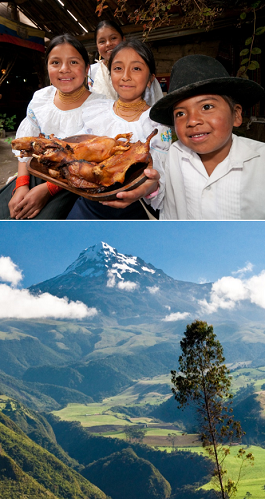 |
|
Quito lies at the foot of the majestic Pichincha volcano and famously blends Andean culture with colonial splendor. Declared a UNESCO World Heritage site in 1978, Quito is known as the Convent of America because of its magnificent plazas, numerous art-filled churches, and colonial architecture. The city is also home to the best-preserved and least altered historic center in Latin America.
In the outskirts of Quito, the Equatorial Line Monument allows you to stand with one foot each in the southern and northern hemispheres. The next-door interactive museum Intiñan offers fascinating experiments to study the effects of the Equatorial Line, like balancing an egg on a nail.
For a great panoramic view of the city, you can travel skywards on the "teleferico", South America’s highest cable car. It takes its passengers up the Pichincha Volcano from 2,950m (9,679ft) to 4,050m (13,287ft) and on the top you have your choice of moderate trekking routes.
If you are looking for souvenirs, a short drive takes you to the famous handicrafts market of Otavalo, one of the biggest of its kind in South America. The colorful stalls are filled with hand woven crafts like belts, tapestries, ponchos, carpets, sweaters, and more. The nearby town of Cotacachi is Ecuador`s leatherwork center and home to artisan shops filled with handmade leather objects.
Quito is also a great starting point for explorations of the surrounding highlands, including Ecuador`s second highest volcano Cotopaxi (5,897m/19,347ft) and the stunning crater lakes Cuicocha and Quilotoa.
|
 |
|
 |
|
SAT TIP: REMOTE LUXURY AT QUITO POLO CLUB HOTEL
|
The new suites at Quito Polo Club offer comfort in the middle of the Ecuadorian country side and are perfect for everybody who is looking to escape the buzzing city. The hotel is located on 20 hectares of land 20min from the airport and 30min from the city. The location also offers quick access to attractions such as Otavalo, Cotacachi, the Cuicocha crater lake, and others.
The hotel's 9 suites are situated in beautifully designed cottages that combine rural and modern design. Large windows and glass walls open to private patios and offer ample views of the garden or the lake.
Besides polo classes and horseback riding, the hotel also features an outdoor tennis court, 2 outdoor swimming pools, a children's pool, a soccer field, a restaurant and 3 bars/lounges.
If you would like to know more, please contact us! |
|
CLOUD FOREST, HOT SPRINGS AND ADVENTURE
|
 |
|
There are a number of towns in close distance to Quito that deserve a closer look.
Papallacta is located at an altitude of 3,300m (10,826ft.) between the Cayambe and Antisana Reserves, it is famous for its beautiful hot springs. Besides soaking in the thermal waters, you can admire the stunning Andean landscapes, take a walk in nature, and appreciate the different species of birds and orchids. Baños is a popular weekend get-away and gateway to the Amazon. Its rivers and waterfalls make it the ideal place for outdoor adventures like rafting, canyoning or zip-lining. Another highlight is the "swing at the end of the world", a swing at the edge of a
cliff at 2,600m (8,530ft) with a view of the Tungurahua Volcano. The lush, misty and cool cloud forest, characterized by a persistent, frequent or seasonal low-level cloud cover, shows yet another side of Ecuador's landscape. It can be found for example near the city of
Mindo and covering the steep slopes of the Andean mountains at an altitude between 1.180 and 4.780m (3.871-15.682ft). These evergreen forests offer an incredible biodiversity; so much that even the north western Andes are declared a biodiversity hotspot. Besides nature explorations, the forests are also great for adventure sports such as tubing, rappel and mountain biking.
|
|
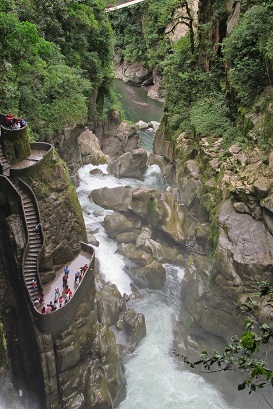 |
 |
|
 |
THE FARTHEST POINT FROM EARTH'S CENTER, INCA RUINS AND PANAMA HATS
|
 |
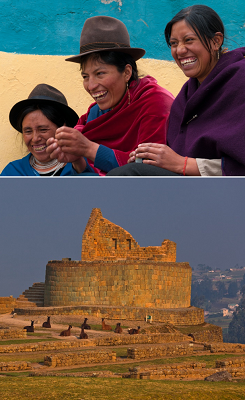 |
|
Once you have left Quito behind and drive south, you will pass by the Chimborazo National Park. The Chimborazo is not only Ecuador's highest mountain (6,263m / 20,548ft.) but its peak is reported to be the farthest point on the surface from Earth's center and therefore the closest point to the moon! Besides that, the national park allows visitors to explore the unique local flora and fauna. You can spot llamas, alpacas and vicuñas as well as Andean condors and other bird species.
Riobamba is another pit-stop that is worth your while. Travel back in time as you walk along the narrow cobblestone streets in the city’s historical center that is filled with colonial buildings, churches, and large arcaded plazas. The Spanish colonization architecture is imposing, yet people have maintained their strong indigenous presence. Located at an elevation of 2,754m (9,035ft.), it is a great starting point for many nearby mountain excursions, for example to the Chimborazo volcano, Ecuador’s highest peak with an altitude of 6,268m (20,564ft.).
Next on our tour is Ingapirca, one of Ecuador's most important archeological site that belonged to two cultures: the Cañari and the Incas. Here you can admire their different architecture styles and stonework, the aqueduct system that provides water for the entire site, and learn about both cultures' customs, beliefs, and rituals.
|
 |
|
 |
|
SAT TIP: CHIMBORAZO LODGE AND COMMUNITY TOURISM IN RIOBAMBA
|
If you plan to explore the Chimborazo National Park, we recommend a stay at Chimborazo Lodge, the only accommodation inside the park. The lodge's 12 rustic rooms are lovingly decorated with gabled wooden ceilings and offer a stunning view of the mountain panorama. The facilities are simple but cozy and heating in the rooms assures a comfortable stay. The on-site restaurant serves international for the daily breakfast and dinner. There is no cell service or WiFi signal which allows you to immersive yourself in the surrounding nature.
Once in Riobamba, a visit to the Palacio Real Community is well worth a visit. Guided walks teach you about local flora and fauna, there is a museum dedicated to the origin and evolution of llamas, local weavers create colorful masterpieces with llama wool and the restaurant serves authentic dishes including quinoa and llama meat.
In order to plan your stay or visit, please contact us! |
|
PANAMA HATS AND THE VALLEY OF LONGEVITY
|
 |
|
Cuenca is located in southern Ecuador at an altitude of 2,500m (8,202ft.). The city is filled with history and colonial magnificence. As you stroll along the cobblestone streets, appreciate the historical center with its architecture, plazas, and cathedrals that are an important part of Ecuador’s heritage. Cuenca is also considered Ecuador’s main arts center and is home to many famous artists like Eduardo Vega (ceramics) and Simon Cordero (jewelry). One of the city's most famous exports is the
Panama hat. Unbeknownst to many, the hat didn't actually originate in Panama but in Ecuador and only received its name when hat makers took their craft to Panama to increase trade volume.
Outdoor and trekking lovers should visit the Cajas National Park, located just 30km from Cuenca at an altitude between 3,200m and 4,500m (10,498 and 14,763ft.). The high altitude grasslands offer diverse flora and fauna, breathtaking waterfalls, glacier lakes, and impressive rock formations. Avid birdwatchers will love to search for species like the condor, the sword-billed, and many more.
Further south, the small village
Vilcabamba welcomes visitors with the beautiful panorama of the Mandango Mountain overlooking the Vilcabamba valley. The region rose to fame as the "Valley of Longevity" since its inhabitants claim to lead longer than average life. It is also a starting point to venture into the
Podocarpus National Park which is estimated to be home to over 3000 different species of plants and orchids, 40% of which are endemic. Its biodiversity is incredible: over 600 bird species, 61 types of hummingbirds, different mammals, butterflies, and insects live here!
|
|
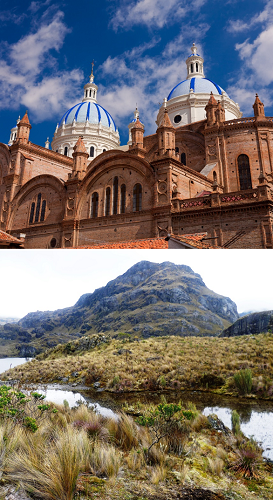 |
 |
|
 |
|
SAT TIP: SMALL BOUTIQUE HOTEL CRUZ DEL VADO AND A DAY IN THE COUNTRYSIDE
|
 |
Art Hotels opened their new small boutique hotel in El Vado, one of the oldest neighborhoods of Cuenca. The property was designed according to their credo to "passionately and authentically mix old with new and create an artistic, creative approach to luxury hospitality". The Hotel Cruz del Vado features 27 rooms in 4 categories, perfect for a relaxed and intimate stay. The facilities include a restaurant, a rooftop bar, a handicraft and souvenir boutique and an art gallery.
If you want to get out of the city, we recommend visiting the small highland villages around Cuenca. In Gualaceo, Chordeleg, and Sigsig, you can learn about weaving, pottery, and metalwork traditions that have been passed down for generations. Or how about an excursion to an orchid farm in Ecuagenera? The altitude and temperatures are ideal to grow orchids from the country’s different microclimates. During the visit, you learn about the farm's conservation program and how orchids are grown and cared for.
Please contact us for details! |
 |
|
 |
THE COAST: METROPOLITAN LIFESTYLE MEETS BEACH PARADISE
|
 |
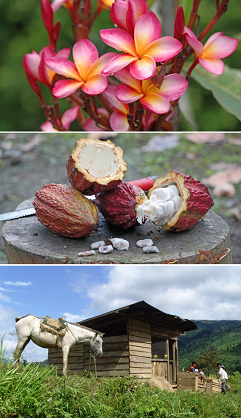 |
|
The coastal region of Ecuador is defined by the land between the Pacific Ocean and the western Andean mountain range and is home to approximately 40% of the Ecuadorian population. Not only does the area boast beautiful and unspoiled sandy beaches, it also has the country´s most fertile and productive land with banana, cacao and coffee plantations.
Ecuador's largest city and commercial center, Guayaquil, is located at the coast, more specifically on the western bank of the Río Guayas. Its port is an important stop for international imports and exports on the Pacific coast. The city has a very lively and growing art scene, the center of which is Las Peñas, the oldest and most picturesque neighborhood. Many of its 400-year-old colonial houses have become art galleries or workshops and visitors can admire open-air painting or sculpture exhibitions.
For a bit of beach time, head to Salinas, a former fishing village located on Ecuador’s most western point. White sandy beaches like Punta Carnero, Ancon, and Anconcito are perfect for relaxing, swimming or observing local wildlife. Between mid-June and October, hunchback whales pass by the coast and Puerto Lopez is just the town to embark on a whale watching expedition. A short boat ride also takes you to Isla de la Plata, where you can observe blue-footed boobies and other species that are common in the famous Galápagos Islands.
|
 |
|
 |
|
SAT TIP: LUXURY COASTAL CRUISE WITH KONTIKI EXPEDITIONS
|
 |
|
Travelers who seek the privacy and luxury of small-yacht expeditions will soon be able to find just that in Ecuador. At the end of this year, Kontiki Expeditions will launch a unique Boutique Sea Expedition, offering one of the most exclusive ways to explore the beauty, wildlife and nature along Ecuador's coast aboard a private yacht. The vessels are equipped with nine modern staterooms, a sundeck, a gourmet salon, two outdoor lounges, bar, Jacuzzi, and a gym and fitness area.
The 8-day journey will take you from the port city of Manta further south to the wildlife paradise Isla de la Plata and the beautiful Machalilla National Park, ending in Guayaquil (or vice versa). Along the way, you will pass through small, uncrowded towns and historical sites, forests and wetlands, pristine beaches and protected ecological reserves. The daily guided tour program focuses on conscious travel and immersive experiences. A fundamental part of the program is supporting the native communities.
|
 |
|
 |
|
THE AMAZON: LUSH VEGETATION AND WILDLIFE HOTSPOT
|
 |
|
The Amazon rainforest of Ecuador is locally known as "el Oriente" (the East) since it stretches along the country's eastern region. It covers approximately half of Ecuador´s total area with less than 5% of the population and just embraces tropical dense rainforest elevated over 400m (1.312ft) above sea level. Due to the vicinity of the Andes, the climate is less tropical and humid compared to other Amazon regions in South America.
With approximately 40,000 species of plants and over 400 species of both mammals and reptiles it is the most bio diverse area in the world. The animals that can mostly be observed include tapirs, monkeys, ocelots, bears, jaguars and lots of different species of birds.
Your Amazon experience is easily customizable and there are options for everybody. We recommend to plan at least 3 nights in order to fully embrace your Amazon experience. From Quito, the Amazon region can be reached either by bus (6-7h) or by plane (35min). The best-known gateways to the Amazon are the cities
Lago Agrio, Tena and Coca. If you prefer a lodge stay, the whole Oriente is open to you since great lodging can be found throughout the entire region. For those who are travelling on a bigger budget, a cruise might be just the way to go. There are currently only two vessels that cruise the Napo River and promise a luxury experience. They leave from Coca to explore the Yasuni National Park and the Cuyabeno Reserve, an area which is less frequented by travelers.
Whichever experience you pick, you will be absolutely amazed by the sheer variety of plants and wildlife that await you!
|
|
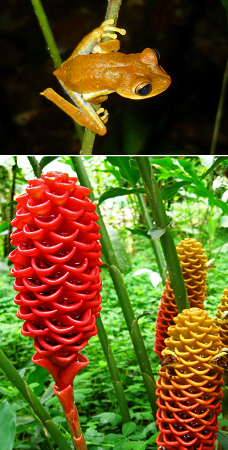 |
 |
|
 |
|
SAT TIP: LA SELVA AMAZON ECOLODGE
|
 |
The
La Selva Ecolodge is located in the heart of the Amazon Rainforest basin, on the border of Yasuni National Park. Starting in the town of Coca, you follow the Napo River down for about 96km (60mi) and then travel inland from the river for another 1,6km (1mi). The lodge is situated deep in the nearly two million acres of the Achuar people's traditional territory near the confluence of the Pastaza and Capahuari Rivers near the Peruvian border. It features 19 suites in 3 categories. The cabanas are inspired by native bamboo design: authentic, airy and comfortable with all amenities
including private bathrooms, hot showers, mosquito nets, WiFi, electricity and ceiling fans. Each features either a private balcony or porch to fully enjoy the view. The public area includes a dining room with rooftop lookout point, an open-air bar, a lounge with wrap-around view of the lake and an observation tower. Spa treatments and yoga retreats complete your stay. The excursions include jungle walks, canoe rides and piranha fishing as well as visits to a parrot clay lick, a Kichwa family and a butterfly farm.
To learn about packages and rates, please contact us! |
 |
|
 |
|
GALÁPAGOS: VOLCANIC ISLANDS AND ENDEMIC SPECIES
|
 |
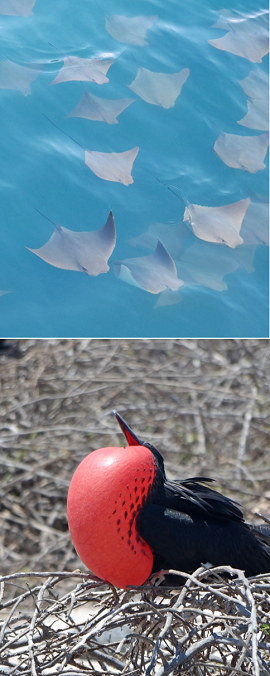 |
|
The Galápagos Islands are an archipelago of volcanic islands situated around 1000km (621mi) to the west of Ecuador´s mainland. The islands are famous for their biodiversity which includes many endemic species of flora and fauna. The archipelago consists of 18 major and 3 minor islands which form a National Park and biological marine reserve.
Only four of the islands are inhabited.
Santa Cruz is the second largest island and is located in the middle of the archipelago. Colonized in the 1920’s, Puerto Ayora is the biggest settlement with the most important harbor in the Galápagos. After Isabela Island, Santa Cruz is home to the second largest population of giant tortoises (about 3000). San Cristóbal has the second largest settlement of the archipelago. At the south, Puerto Baquerizo Moreno is the Galápagos province capital where most people work in government, tourism, and artisanal fishing. Isabela is the
archipelago’s biggest island and occupies about 60% of the land area. About 1 million years ago, the merger of 6 volcanoes formed the island and 5 of them remain active until today. Isabela’s unique landscape, lava fields, beautiful beaches, and relaxing atmosphere offer travelers a matchless experience in nature.
Floreana was one of the first islands to be inhabited and has a lively history including being set alight as a result of a prank gone wrong, unsolved disappearances and suspicious deaths. It is also famous for a wooden barrel that was being used for mail delivery by whalers. It still exists today and people place their cards there without postage so visitors who sift through them can deliver them by hand.
The main highlight by far is the observation of marine and land-based wildlife. An unexpected peculiarity is that some animals, such as sea lions, penguins, and blue-footed boobies do not seem to fear humans which makes it easy to observe them and capture the perfect picture. However, there strict rules about keeping your distance from the animals as to not disturb them.
No visit to the islands is complete without relaxing at the beautiful beaches or taking a dive into the turquoise waters to explore its lively marine world filled with schools of fish, white-tip sharks, and great manta rays.
|
 |
|
 |
|
SAT TIP: ROYAL PALM GALAPAGOS
|
|
The Royal Palm Hotel Galápagos, located in the lush Miconia Highland Forests on Santa Cruz Island, is one of the best hotel options to explore this unique natural paradise. The secluded hotel is surrounded by beautiful nature and endemic species to be discovered, and yet only 25min from the main town of Puerto Ayora. Spacious villas and a wide hotel estate of more than 165 hectares offer comfort and tranquility. Daily guided tours include visits to the lava tunnels within the hotel estate, two gigantic craters as well as observing wild giant tortoises
in their natural habitat. Boat excursions to nearby islands of the archipelago provide great opportunities to see sea lions, magnificent frigatebirds, the beloved blue-footed boobies as well as land and sea iguanas and many more!
|
 |
|
 |

|
 |
|
 |
South American Tours - Global Sales Office
South American Tours GmbH | Kaiserstr. 23 | 60311 Frankfurt am Main | Germany
Phone: +49 (0) 69 4058970 | Fax: +49 (0) 69 40589799
Mail: sales@southamericantours.com | www.southamericantours.com
South American Tours - Sales Office North America
Mail: sales-america@southamericantours.com
Copyright © South American Tours 2012-2020
Imprint
South American Tours de Uruguay Agencia de Viajes S.A. | Buenos Aires 618, Piso 2, Oficina 201 | 11000 Montevideo | Uruguay
Tel.: +59 82 91 60 050 | Fax.: +59 82 91 55 406 | E-mail: info@southamericantours.com
Managing Director: Federico Büker | Registered Office: Montevideo | Local Court: Montevideo | Commercial Register: 1194 (Ministry of Tourism) | VAT identification no.: 215224020014

|
|
Protection of data privacy and cancellation of the subscription:
This message has been sent to {EMAIL}. If you do not want to receive mails in the future you can unsubscribe by clicking
here.
|
|
|
 |
|
 |
 |
|
|